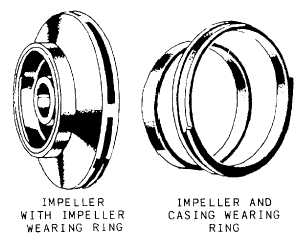The packing should not block off the liquid seal
line connection to the lantern ring after the gland
has been tightened.
Figure 9-6 shows how the packing is arranged.
Notice how the lantern ring lines up with the
liquid seal connection when the gland is tightened.
Renewing Shaft Sleeves.— In some pumps the
shaft sleeve is pressed onto the shaft tightly by
a hydraulic press. In this case, the old sleeve must
be machined off with a lathe before a new one
can be installed. On others, the shaft sleeve may
have a snug slip-on fit, butted up against a
shoulder on the shaft and held securely in place
with a nut. On smaller pumps, new sleeves can
be installed by removing the water end casing,
impeller, and old shaft sleeves. New sleeves are
carried as repair parts; they can also be made in
the machine shop. On a large pump, the sleeve
is usually pressed on; the old sleeve must be
machined off before a new one can be pressed on.
You must disassemble the pump and take the
sleeve to a machine shop, a repair shop, or a naval
shipyard to have this done.
To prevent water leakage between the shaft
and the sleeve, some sleeves are packed, others
have an O-ring between the shaft and the
abutting shoulder. For detailed information,
consult the appropriate manufacturer’s technical
manual or applicable blueprint.
Renewing Wearing Rings.— The clearance
between the impeller and the casing wearing ring
(fig. 9-7) must be maintained as directed by
the manufacturer. When clearances exceed the
specified amount, the casing wearing ring must
be replaced. On most ships, this job can be done
by the ship’s force, but it requires the complete
disassembly of the pump. All necessary informa-
tion on disassembly of the unit, dimensions of the
wearing rings, and reassembly of the pump is
specified by PMS or can be found in the manufac-
turer’s technical manual. Failure to replace the
casing wearing ring when the allowable clearance
is exceeded results in a decrease of pump capacity
and efficiency. If a pump has to be disassembled
because of some internal trouble, the wearing ring
should be checked for clearance. Measure the
outside diameter of the impeller hub with an
outside micrometer and the inside diameter of the
casing wearing ring with an inside micrometer; the
difference between the two diameters is the
actual wearing ring diametric clearance. By
checking the actual wearing ring clearance with
the maximum allowable clearance, you can decide
whether to renew the ring before reassembling the
pump. The applicable MRCs area readily available
source of information on proper clearances.
Wearing rings for most small pumps are
carried aboard ship as part of the ship’s repair
parts allowance. These may need only a slight
amount of machining before they can be installed.
For some pumps, spare rotors are carried aboard
ship. The new rotor can be installed and the old
rotor sent to a repair activity for overhaul.
Overhauling a rotor includes renewing the
wearing rings, bearings, and shaft sleeve.
Operating Troubles.— You will be responsible
for the maintenance of centrifugal pumps. The
following table is a description of some of the
problems you will have to deal with together with
the probable causes:
TROUBLE
CAUSE
Does not deliver any Insufficient priming
liquid
Insufficient speed of the
pump
Excessive discharge pressure
(such as a partially closed
valve or some other obstruc-
tion in the discharge line)
Excessive suction lift
Clogged impeller passages
Wrong direction of rotation
Clogged suction screen (if
used)
Figure 9-7.—Impeller, impeller wearing ring, and casing
wearing ring for a centrifugal pump.
Ruptured suction line
Loss of suction pressure
9-6


